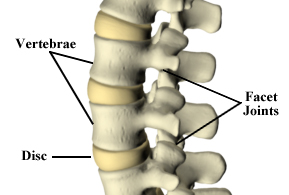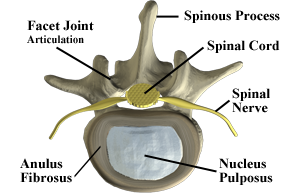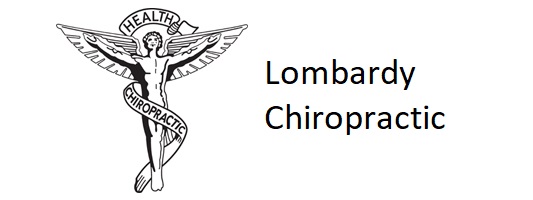The Spine: Support System for Body
The spine is composed of many parts that function together to allow you to move...and a whole lot of other things! Let’s focus on movement for now.



The vertebrae are the bony segments of your spine. They are joined to each other throughout the spine by "articulations" that allow smooth movement between the bones. The round part of the vertebra is called the "body" and the pointy part to the back is the "spinous process."
Within each section, there are a number of bones named for their number in the segment: 7 cervical vertebrae (C1-C7), 12 thoracic vertebrae (T1-T12), 5 lumbar vertebrae (L1-L5), 1 sacrum made of 5 fused vertebrae, 1 coccyx made of 4 fused coccygeal vertebrae. The coccyx is the lowest point of the spine that bends when you sit down and acts like a shock absorber while you sit. It's also known more commonly as the tailbone.
Facet joints connect the vertebrae of the spine and allow movement. One faces up and one faces down to connect with the adjacent vertebrae.
The intervertebral disc (or disc for short) acts like the shock absorber of the spine. There are cervical spine intervertebral discs, lumbar spine intervertebral discs, and thoracic spine intervertebral discs. It holds the bony vertebrae apart and gives space in the spinal canal for the spinal cord and its nerves to pass through on their way to the extremities of the body. Its center is the “nucleus pulposus” which is normally 80% water-filled. The outer part is the “annulus fibrosus” which is made of rubberband-like rings (annular fibers) which hold the nucleus in place.
Spinal nerves receive information from the disc and the facet joints, muscles, tendons, and ligaments. The nerves interpret this information as to touch, pressure, temperature, and, if the nerves are excessively compressed or irritated, produce pain. The spinal nerves conduct messages from the body and send them to brain for interpretation, and the brain produces a response to irritation whether that be a response of comfort or pain.
The spinal column has 4 curves - cervical, thoracic, lumbar and sacral - and 5 sections - cervical (C1-C7), thoracic (T1-T12), lumbar (L1-L5), sacral (S1-S5), and coccygeal.
- Two curves are concave posteriorly (cervical and lumbar).
- Two are concave anteriorly (thoracic and sacral).
So, what's up with your spine? Take a quiz or just simply contact your knowledgeable Augusta chiropractor at Lombardy Chiropractic Clinic. We'll figure it out together, and get you back to enjoying your life!
